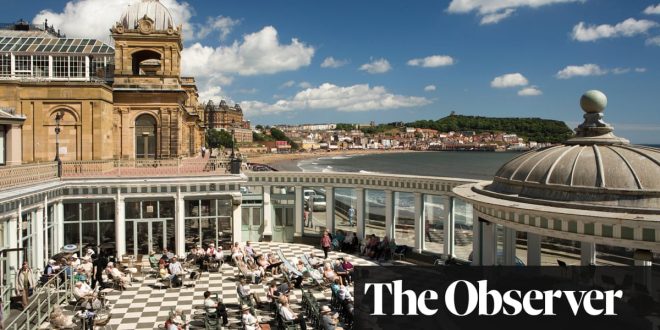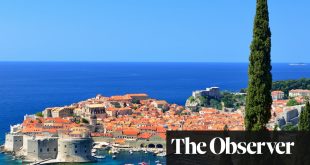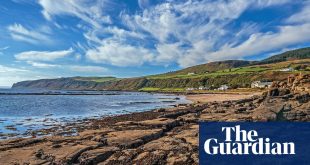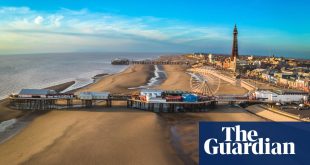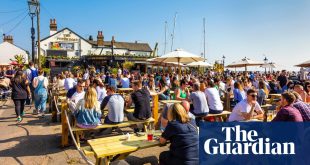The Grand is a dog-eared Cluedo board of a hotel. The art deco ballroom, its sprung dancefloor covered by carpet, opens into a library used for community events, which in turn leads to an enormous dining room, while the other wing has a billiards room.
Everything in this Folkestone landmark is a bit higgledy-piggledy: spare tables and chairs shoved to one side, curtains askew, a grand piano here and there. A 1920s-style mural completes the Agatha Christie feel. There’s even a stray three-pronged candlestick.
The man with the black envelope is Pierre Condou, a restaurateur with a pedigree in London’s members’ clubs and part of a community group that plans to restore the Grand to its former grandeur, back when King Edward VII held court at the seaside here with his mistress, Alice Keppel, at the start of the 20th century. “It was like getting the keys to the sweet shop,” says Condou, striding around the room. “There is so much potential.”
He wants to transform the entrance, an airy atrium with chequerboard tiles known as the Palm Court, into a modern brasserie, and create an events space in the public rooms, for weddings or corporate events.
“Folkestone, the whole Kent coast and seaside resorts generally in Great Britain, I think, are on the verge of a renaissance,” he says.
Condou is betting on the Grand’s future success because of the influx of DFLs – Down From London – who moved here when the Covid pandemic demonstrated that working from home was viable, coupled with investment in Folkestone by Sir Roger De Haan, whose father founded the Saga holiday group.
“All these factors are beginning to revive the holiday destination market of coastal communities.”
Others agree and many are building new hotels rather than restoring old ones. In Southport, entrepreneurs plan to create the Cove Resort, a £75m surf park complex on the Lancashire coast, with a hotel and thermal spa, to go with a £73m event space on the seafront being built by the local authority.
On the other side of the Ribble estuary in Blackpool, people have been opening upmarket, Insta-ready hotels in the home of seaside kitsch, such as Big Blue and the restored Number One South Beach.
And on the south coast, in Poole, another community has ambitious plans to rebuild the Haven hotel, once used by the inventor and physicist Guglielmo Marconi in his work developing radio.
“It’s an iconic site coming into Poole harbour, and it has a heritage,” said Norman Allenby Smith, chairman of the Sandbanks Community Group. The residents spent seven years fighting plans to demolish the hotel in favour of 119 luxury flats and, after winning one planning battle, decided to come up with their own vision, paying architect Philip Gumuchdjian to create plans for it.
“There would be a new hotel on the site with an aerial radio tower on top of the building to mark the Marconi heritage,” Allenby Smith said. “Life has changed in the last seven years. Good hotels on iconic sites are still very popular. People want to come and stay three or five days, not necessarily the two-week bucket and spade type thing. A number of the hotel groups would be very keen to occupy that building if we get permission for it.”
Peter Hampson, chief executive of British Destinations, said that although seaside resorts had remained much more popular than is often portrayed, British beach hotels now had a lot more competition than in the past.
“The radical change in the holiday market is that people go on holidays to cities now,” he said. “Mass tourism used to be about people getting away from cities into the fresh air. But the main threat to hotels is the explosion in Airbnb accommodation.”
Visitors stayed 29m nights in a rented house or flat last year, 5m more than in 2019, according to the International Passenger Survey, compared with nearly 91m nights in hotels, about 4m fewer than in 2019.
“Airbnb, in UK terms, has always said to government, oh we’re just augmenting hotels,” Hampson said. “But now they’ve switched their international marketing. Their adverts say Airbnb is better than a hotel.
after newsletter promotion
“And that is interesting because there is a moral economic dilemma – should you be encouraging people to convert residential homes to accommodation to compete directly with the traditional hotel? Because what happens to hotels if they go bust? They’ll get converted into residential properties.”
That describes what happened to the Grand. When it opened in 1903, The Grand’s founder, Gustave Gelardi, marketed his accommodation as 30 suites of “gentlemen’s residential chambers” where fashionable men could rent their quarters for the holiday season. There was accommodation for chauffeurs and maids, kitchens and gardens and all arranged, as a newspaper review of the time described it, so that “one can enjoy the seclusion of his own house, as it were, and yet have all the advantages and conveniences of a large hotel”.
According to Emre Araci’s book The Grand Revisited, Edward VII would spend weekends at the Grand with Keppel, a society hostess and aristocrat who is the great-grandmother of Queen Camilla.
“When the royal entourage took their seats in the Palm Court, the locals were peering through the windows, so much so that [it] came to be called the monkey house.”
The collision of the upper and lower classes is behind much of the seaside’s history. Spending time at the sea was the preserve of rich people, who would find lodgings for several weeks. Hotels were a way for the wealthy to get away from the ordinary people flocking to the seaside on Britain’s growing railway network.
“Hotels were slightly off to the edge of where all the bedlam was going on, almost like gated communities,” said Dr Allan Brodie, a historian at the University of Bournemouth and part of the Seaside Heritage Network team. The first big hotels such as the Grand in Brighton and the Grand in Scarborough arrived in the 1860s, and the building spree continued until the 1930s, when holiday camps arrived.
By the 1970s, after hosting luminaries such as prime minister Joseph Chamberlain and the writer Evelyn Waugh, the Grand closed down, as Folkestone fell out of fashion.
The rooms were converted into apartments and bought by Michael Stainer, who set up tea rooms and a pub in the building. He was jailed in 2022 for tax fraud after failing to pay £470,000 of his employees’ taxes.
To pay for the building’s upkeep, the Grand’s residents intend to convert parts of the lower ground floor into 24 new holiday lets, with 13 going up for sale this week. Money from the holiday lets will be used to fit out a new restaurant and commercial space.
“The Grand can be revived,” says Condou. “It’s just falling into disrepair and needs modernising.”
 Top Naija News – Nigeria News, Nigerian News & Top Stories Top Naija News – Nigerian Newspapers, Nigerian News. topnaijanews is a daily Nigerian newspaper covering Latest News, Breaking News, Entertainment, Sports, Lifestyle and Politics.
Top Naija News – Nigeria News, Nigerian News & Top Stories Top Naija News – Nigerian Newspapers, Nigerian News. topnaijanews is a daily Nigerian newspaper covering Latest News, Breaking News, Entertainment, Sports, Lifestyle and Politics.
